Analysis of Interface Fusion Effect between Old and New Asphalt under Plant Mixing and Cold Recycling Mode Based on Molecular Dynamics Simulation
Abstract
:1. Introduction
2. Molecular Simulation Modeling
2.1. Introduction of Molecular Simulation Technique
2.2. Establishment of Asphalt Molecular Model
2.2.1. Materials
2.2.2. Molecular Simulation Method
- First, the construction in amorphous cell module was used to model the asphalt molecules.
- Second, the geometry optimization was accomplished by the Forcite module.
- Last, the anneal function of the Forcite module was used to backpedal asphalt molecules, in which the initial temperature is 300 K, the intermediate temperature is 500 K, and 25 cycles were carried out; the models are shown in Figure 2.
3. Asphalt Model and Diffusion System
3.1. Material Parameters
3.1.1. Density
3.1.2. Solubility Parameter
3.2. Atomic Radial Distribution Function
3.3. Establishment Method of the New-Old Asphalt Diffusion System Model
3.4. Diffusion Evaluation Index of the New-Old Asphalt System
3.4.1. All Azimuth Shift
3.4.2. Diffusion Coefficient
4. Analysis of the Interface Fusion Effect of Old and New Asphalt
4.1. Diffusion Process Analysis
4.2. Diffusion of New Asphalt to Old Asphalt
4.3. Diffusion of Old Asphalt to New Asphalt
4.4. Comparison of Diffusion between Two Asphalt Types
4.5. Influence of Different Rejuvenators and Dosage on Diffusion
5. Application Prospect
6. Conclusions
Author Contributions
Funding
Institutional Review Board Statement
Informed Consent Statement
Data Availability Statement
Acknowledgments
Conflicts of Interest
References
- Leng, Z.; Tan, Z.F.; Cao, P.; Zhang, Y. An efficient model for predicting the dynamic performance of fine aggregate matrix. Comput. Aided Civ. Inf. 2021. [Google Scholar] [CrossRef]
- Wang, F.Y.; Qin, X.Y.; Pang, W.C.; Wang, W.S. Performance Deterioration of Asphalt Mixture under Chloride Salt Erosion. Materials 2021, 14, 3339. [Google Scholar] [CrossRef]
- Guo, M.; Liu, H.Q.; Jiao, Y.B.; Mo, L.T.; Tan, Y.Q.; Wang, D.W.; Liang, M.C. Effect of WMA-RAP technology on pavement performance of asphalt mixture: A state-of-the-art review. J. Clean. Prod. 2020, 266, 121704. [Google Scholar] [CrossRef]
- Guo, Q.L.; Liu, Q.; Zhang, P.; Gao, Y.; Jiao, Y.B.; Yang, H.C.; Xu, A.S. Temperature and pressure dependent behaviors of moisture diffusion in dense asphalt mixture. Constr. Build. Mater. 2020, 246, 118500. [Google Scholar] [CrossRef]
- Kaseer, F.; Arambula-Mercado, E.; Cucalon, L.G.; Martin, A.E. Performance of asphalt mixtures with high recycled materials content and recycling agents. Int. J. Pavement Eng. 2020, 21, 863–877. [Google Scholar] [CrossRef]
- Kaseer, F.; Yin, F.; Arambula-Mercado, E.; Martin, A.E. Stiffness Characterization of Asphalt Mixtures with High Recycled Material Content and Recycling Agents. Transp. Res. Rec. 2017, 58–68. [Google Scholar] [CrossRef]
- Zhou, P.L.; Wang, W.S.; Zhu, L.L.; Wang, H.Y.; Ai, Y.M. Study on Performance Damage and Mechanism Analysis of Asphalt under Action of Chloride Salt Erosion. Materials 2021, 14, 3089. [Google Scholar] [CrossRef]
- Lv, S.T.; Liu, J.; Peng, X.H.; Liu, H.F.; Hu, L.; Yuan, J.; Wang, J.P. Rheological and microscopic characteristics of bio-oil recycled asphalt. J. Clean. Prod. 2021, 295, 126449. [Google Scholar] [CrossRef]
- Zhu, J.Q.; Ma, T.; Cheng, H.; Li, T.L.; Fu, J.K. Mechanical Properties of High-Modulus Asphalt Concrete Containing Recycled Asphalt Pavement: A Parametric Study. J. Mater. Civ. Eng. 2021, 33, 04021056. [Google Scholar] [CrossRef]
- Chen, T.; Ma, T.; Huang, X.M.; Ma, S.J.; Tang, F.L.; Wu, S.P. Microstructure of synthetic composite interfaces and verification of mixing order in cold-recycled asphalt emulsion mixture. J. Clean. Prod. 2020, 263, 121467. [Google Scholar] [CrossRef]
- Guo, M.; Tan, Y.Q.; Luo, D.S.; Li, Y.F.; Farooq, A.; Mo, L.T.; Jiao, Y.B. Effect of Recycling Agents on Rheological and Micromechanical Properties of SBS-Modified Asphalt Binders. Adv. Mater. Sci. Eng. 2018, 2018, 5482368. [Google Scholar] [CrossRef] [Green Version]
- Xiao, F.P.; Yao, S.L.; Wang, J.G.; Li, X.H.; Amirkhanian, S. A literature review on cold recycling technology of asphalt pavement. Constr. Build. Mater. 2018, 180, 579–604. [Google Scholar] [CrossRef]
- Diefenderfer, B.K.; Boz, I.; Habbouche, J.; Jones, D.; Hand, A.J. Development and Assessment of Rapid Tests for Construction of Asphalt-Treated Cold Recycled Pavements. Transp. Res. Rec. 2020, 2674, 189–198. [Google Scholar] [CrossRef]
- Sanchez-Cotte, E.H.; Fuentes, L.; Martinez-Arguelles, G.; Quintana, H.A.R.; Walubita, L.F.; Cantero-Durango, J.M. Influence of recycled concrete aggregates from different sources in hot mix asphalt design. Constr. Build. Mater. 2020, 259, 120427. [Google Scholar] [CrossRef]
- Yin, F.; Kaseer, F.; Arambula-Mercado, E.; Martin, A.E. Characterising the long-term rejuvenating effectiveness of recycling agents on asphalt blends and mixtures with high RAP and RAS contents. Road Mater. Pavement 2017, 18, 273–292. [Google Scholar] [CrossRef]
- Elkashef, M.; Williams, R.C.; Cochran, E.W. Thermal and cold flow properties of bio-derived rejuvenators and their impact on the properties of rejuvenated asphalt binders. Thermochim. Acta 2019, 671, 48–53. [Google Scholar] [CrossRef]
- Barzegari, S.; Solaimanian, M. Rheological behavior of bio-asphalts and effect of rejuvenators. Constr. Build. Mater. 2020, 251, 118137. [Google Scholar] [CrossRef]
- Yu, J.M.; Guo, Y.F.; Peng, L.; Guo, F.; Yu, H.Y. Rejuvenating effect of soft bitumen, liquid surfactant, and bio-rejuvenator on artificial aged asphalt. Constr. Build. Mater. 2020, 254, 119336. [Google Scholar] [CrossRef]
- Oldham, D.J.; Fini, E.H.; Chailleux, E. Application of a bio-binder as a rejuvenator for wet processed asphalt shingles in pavement construction. Constr. Build. Mater. 2015, 86, 75–84. [Google Scholar] [CrossRef]
- Zhou, X.X.; Adhikari, S. Flow-induced crystallization of biochar in bio-asphalt under various aging conditions. Sci. Total Environ. 2019, 695, 133943. [Google Scholar] [CrossRef]
- Valdes, G.; Perez-Jimenez, F.; Miro, R.; Martinez, A.; Botella, R. Experimental study of recycled asphalt mixtures with high percentages of reclaimed asphalt pavement (RAP). Constr. Build. Mater. 2011, 25, 1289–1297. [Google Scholar] [CrossRef] [Green Version]
- Wrobel, M.; Woszuk, A.; Ratajczak, M.; Franus, W. Properties of reclaimed asphalt pavement mixture with organic rejuvenator. Constr. Build. Mater. 2021, 271, 121514. [Google Scholar] [CrossRef]
- Softic, E.; Radicevic, V.; Subotic, M.; Stevic, Z.; Talic, Z.; Pamucar, D. Sustainability of the Optimum Pavement Model of Reclaimed Asphalt from a Used Pavement Structure. Sustainability 2020, 12, 1912. [Google Scholar] [CrossRef] [Green Version]
- Tarsi, G.; Tataranni, P.; Sangiorgi, C. The Challenges of Using Reclaimed Asphalt Pavement for New Asphalt Mixtures: A Review. Materials 2020, 13, 4052. [Google Scholar] [CrossRef]
- Skotnicki, L.; Kuzniewski, J.; Szydlo, A. Research on the Properties of Mineral-Cement Emulsion Mixtures Using Recycled Road Pavement Materials. Materials 2021, 14, 563. [Google Scholar] [CrossRef] [PubMed]
- Meroni, F.; Flintsch, G.W.; Diefenderfer, B.K.; Diefenderfer, S.D. Application of Balanced Mix Design Methodology to Optimize Surface Mixes with High-RAP Content. Materials 2020, 13, 5638. [Google Scholar] [CrossRef] [PubMed]
- Fediuk, R. High-strength fibrous concrete of Russian Far East natural materials. IOP Conf. Ser. Mater. Sci. Eng. 2016, 116, 012020. [Google Scholar] [CrossRef] [Green Version]
- Li, C.; Ouyang, J.; Cao, P.; Shi, J.T.; Yang, W.T.; Sha, Y.Q. Effect of Rejuvenating Agent on the Pavement Properties of Cold Recycled Mixture with Bitmen Emulsion. Coatings 2021, 11, 520. [Google Scholar] [CrossRef]
- Jin, D.Z.; Ge, D.D.; Chen, S.Y.; Che, T.K.; Liu, H.F.; Malburg, L.; You, Z.P. Cold In-Place Recycling Asphalt Mixtures: Laboratory Performance and Preliminary M-E Design Analysis. Materials 2021, 14, 2036. [Google Scholar] [CrossRef] [PubMed]
- Yang, J.G.; Sun, C.; Tao, W.J.; Gao, J.; Huang, B.C.; Zhang, J. Laboratory Investigation of Compaction Characteristics of Plant Recycled Hot-Mix Asphalt Mixture. Sustainability 2021, 13, 3005. [Google Scholar] [CrossRef]
- Zhang, L.M.; Gao, X.K.; Wang, W.S.; Wang, H.; Zheng, K.K. Laboratory Evaluation of Rheological Properties of Asphalt Binder Modified by Nano-TiO2/CaCO3. Adv. Mater. Sci. Eng. 2021, 2021, 5522025. [Google Scholar] [CrossRef]
- Wu, C.L.; Li, L.D.; Wang, W.S.; Gu, Z.W. Experimental Characterization of Viscoelastic Behaviors of Nano-TiO2/CaCO3 Modified Asphalt and Asphalt Mixture. Nanomaterials 2021, 11, 106. [Google Scholar] [CrossRef]
- Walubita, L.F.; Gonzalez-Hernandez, J.G.; Martinez-Arguelles, G.; Tanvir, H.; Fuentes, L.; Tahami, S.A. Statistical Evaluation of the Material-Source Effects on the DSR Rheological Properties of Plant-Mix Extracted Asphalt-Binders. Materials 2021, 14, 1931. [Google Scholar] [CrossRef]
- Trautvain, A.I.; Yadykina, V.V.; Mulenko, E.S. Study of physical-mechanical properties of asphalt-concrete specimens on activated mineral powders of various compositions. Constr. Mater. Prod. 2018, 1, 44–50. [Google Scholar]
- Zhao, M.Y.; Shen, F.; Ding, Q.J. Micromechanism of the Dispersion Behavior of Polymer-Modified Rejuvenators in Aged Asphalt Material. Appl Sci. 2018, 8, 1591. [Google Scholar] [CrossRef] [Green Version]
- Xu, C.; Wang, D.Y.; Zhang, S.W.; Guo, E.B.; Luo, H.Y.; Zhang, Z.Y.; Yu, H.Y. Effect of Lignin Modifier on Engineering Performance of Bituminous Binder and Mixture. Polymers 2021, 13, 1083. [Google Scholar] [CrossRef] [PubMed]
- Jin, J.; Chen, B.Z.; Liu, L.; Liu, R.H.; Qian, G.P.; Wei, H.; Zheng, J.L. A Study on Modified Bitumen with Metal Doped Nano-TiO2 Pillared Montmorillonite. Materials 2019, 12, 1910. [Google Scholar] [CrossRef] [Green Version]
- Bessmertnyi, V.S.; Lesovik, V.S.; Krokhin, V.P.; Puchka, O.V.; Nikiforova, E.P. The reducing effect of argon in the plasma treatment of high-melting nonmetallic materials (a review). Glass Ceram. 2001, 58, 362–364. [Google Scholar] [CrossRef]
- Lopes, M.; Gabet, T.; Bernucci, L.; Mouillet, V. Durability of hot and warm asphalt mixtures containing high rates of reclaimed asphalt at laboratory scale. Mater. Struct. 2015, 48, 3937–3948. [Google Scholar] [CrossRef]
- Shi, H.Q.; Xu, T.; Jiang, R.L. Combustion mechanism of four components separated from asphalt binder. Fuel 2017, 192, 18–26. [Google Scholar] [CrossRef]
- Kaseer, F.; Martin, A.E.; Arambula-Mercado, E. Use of recycling agents in asphalt mixtures with high recycled materials contents in the United States: A literature review. Constr. Build. Mater. 2019, 211, 974–987. [Google Scholar] [CrossRef]
- Yu, C.H.; Hu, K.; Yang, Q.L.; Wang, D.D.; Zhang, W.G.; Chen, G.X.; Kapyelata, C. Analysis of the Storage Stability Property of Carbon Nanotube/Recycled Polyethylene-Modified Asphalt Using Molecular Dynamics Simulations. Polymers 2021, 13, 1658. [Google Scholar] [CrossRef] [PubMed]
- Xu, M.; Yi, J.Y.; Feng, D.C.; Huang, Y.D. Diffusion characteristics of asphalt rejuvenators based on molecular dynamics simulation. Int. J. Pavement Eng. 2019, 20, 615–627. [Google Scholar] [CrossRef]
- Zhao, S.; Huang, B.S.; Shu, X.; Jia, X.Y.; Woods, M. Laboratory Performance Evaluation of Warm-Mix Asphalt Containing High Percentages of Reclaimed Asphalt Pavement. Transp. Res. Rec. 2012, 98–105. [Google Scholar] [CrossRef]
- Mogawer, W.S.; Austerman, A.J.; Bonaquist, R.; Roussel, M. Performance Characteristics of Thin-Lift Overlay Mixtures High Reclaimed Asphalt Pavement Content, Recycled Asphalt Shingles, and Warm-Mix Asphalt Technology. Transp. Res. Rec. 2011, 2208, 17–25. [Google Scholar] [CrossRef]
- Cao, W.; Mohammad, L.N.; Elseifi, M. Assessing the effects of RAP, RAS, and warm-mix technologies on fatigue performance of asphalt mixtures and pavements using viscoelastic continuum damage approach. Road Mater. Pavement 2017, 18, 353–371. [Google Scholar] [CrossRef]
- Mangiafico, S.; Sauzeat, C.; Di Benedetto, H.; Pouget, S.; Olard, F.; Planque, L. Quantification of biasing effects during fatigue tests on asphalt mixes: Non-linearity, self-heating and thixotropy. Road Mater. Pavement 2015, 16, 73–99. [Google Scholar] [CrossRef]
- Wang, L.; Zhang, L.; Liu, Y. Compatibility of Rubber Powder and Asphalt in Rubber Powder Modified Asphalt by Molecular Dynamics. J. Build. Mater. 2018, 21, 689–694. [Google Scholar]
- Redelius, P.; Soenen, H. Relation between bitumen chemistry and performance. Fuel 2015, 140, 34–43. [Google Scholar] [CrossRef]
- Cui, W.T.; Huang, W.K.; Hu, B.; Xie, J.W.; Xiao, Z.C.; Cai, X.; Wu, K.H. Investigation of the Effects of Adsorbed Water on Adhesion Energy and Nanostructure of Asphalt and Aggregate Surfaces Based on Molecular Dynamics Simulation. Polymers 2020, 12, 2339. [Google Scholar] [CrossRef]
- He, L.; Li, G.N.; Lv, S.T.; Gao, J.; Kowalski, K.J.; Valentin, J.; Alexiadis, A. Self-healing behavior of asphalt system based on molecular dynamics simulation. Constr. Build. Mater. 2020, 254, 119225. [Google Scholar] [CrossRef]
- Ramezani, M.G.; Rickgauer, J. Understanding the adhesion properties of carbon nanotube, asphalt binder, and mineral aggregates at the nanoscale: A molecular dynamics study. Pet. Sci. Technol. 2020, 38, 28–35. [Google Scholar] [CrossRef]
- Mangiafico, S.; Di Benedetto, H.; Sauzeat, C.; Olard, F.; Pouget, S.; Dupriet, S.; Planque, L.; Van Rooijen, R. Statistical analysis of the influence of RAP and mix composition on viscoelastic and fatigue properties of asphalt mixes. Mater. Struct. 2015, 48, 1187–1205. [Google Scholar] [CrossRef]
- Arambula Mercado, E. Influence of Fundamental Material Properties and Air Void Structure on Moisture Damage of Asphalt Mixes. Ph.D. Thesis, Texas A&M University, College Station, TX, USA, 2007. [Google Scholar]
- Zureigat, H.; Ismail, A.I.; Sathasivam, S. A compact Crank-Nicholson scheme for the numerical solution of fuzzy time fractional diffusion equations. Neural Comput. Appl. 2020, 32, 6405–6412. [Google Scholar] [CrossRef]
- Bhasin, A.; Bommavaram, R.; Greenfield, M.L.; Little, D.N. Use of Molecular Dynamics to Investigate Self-Healing Mechanisms in Asphalt Binders. J. Mater. Civ. Eng. 2011, 23, 485–492. [Google Scholar] [CrossRef]
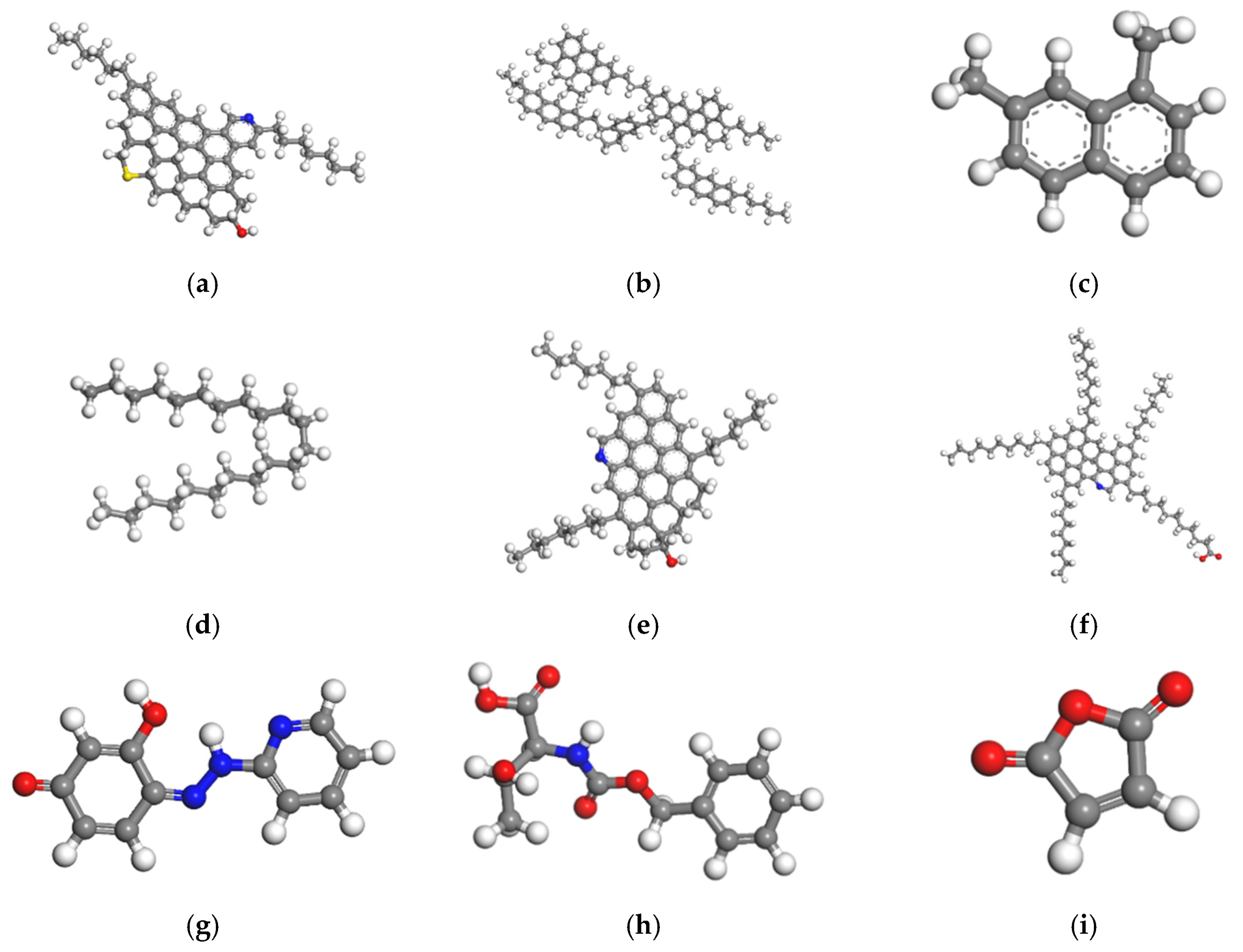
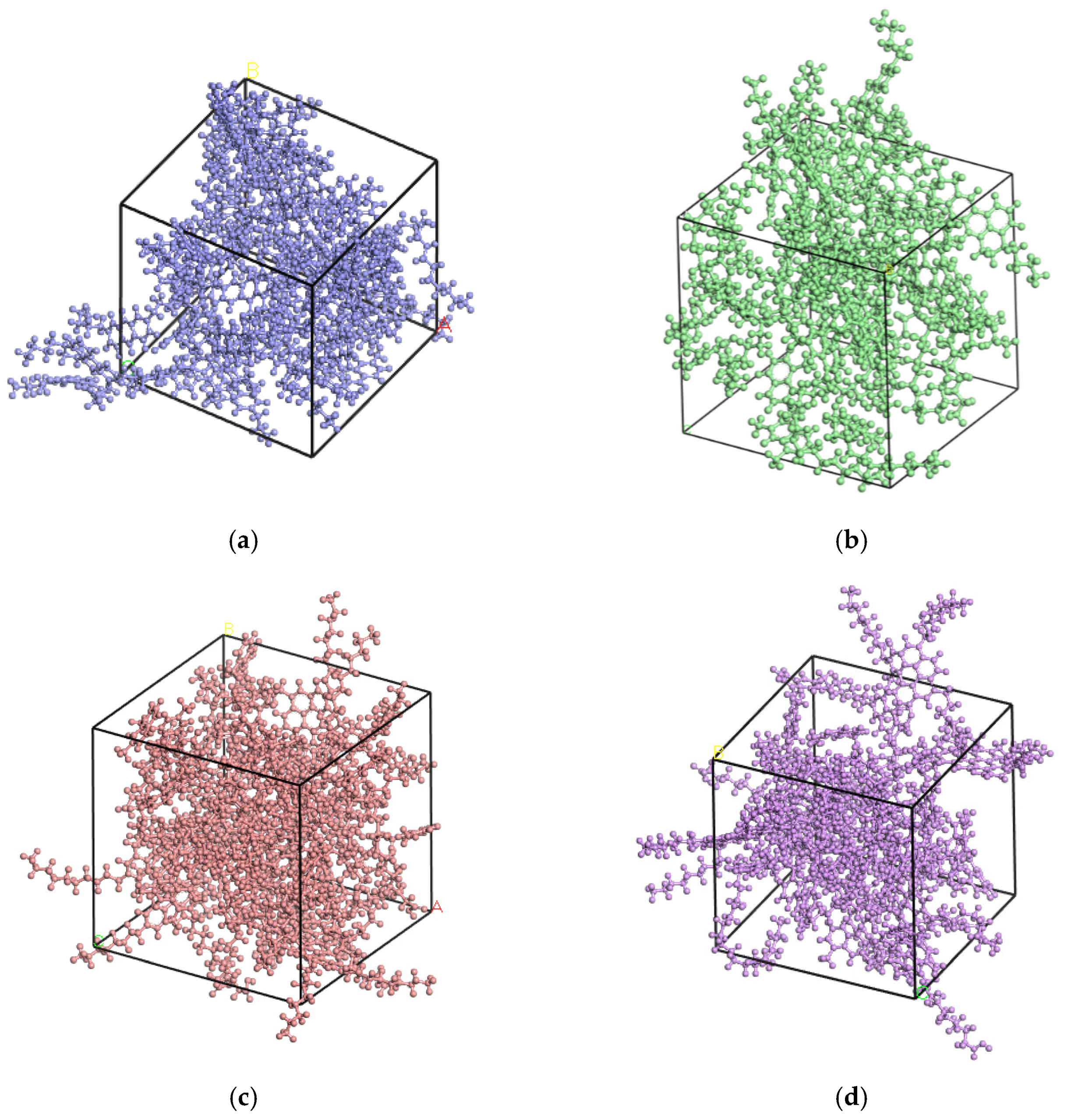
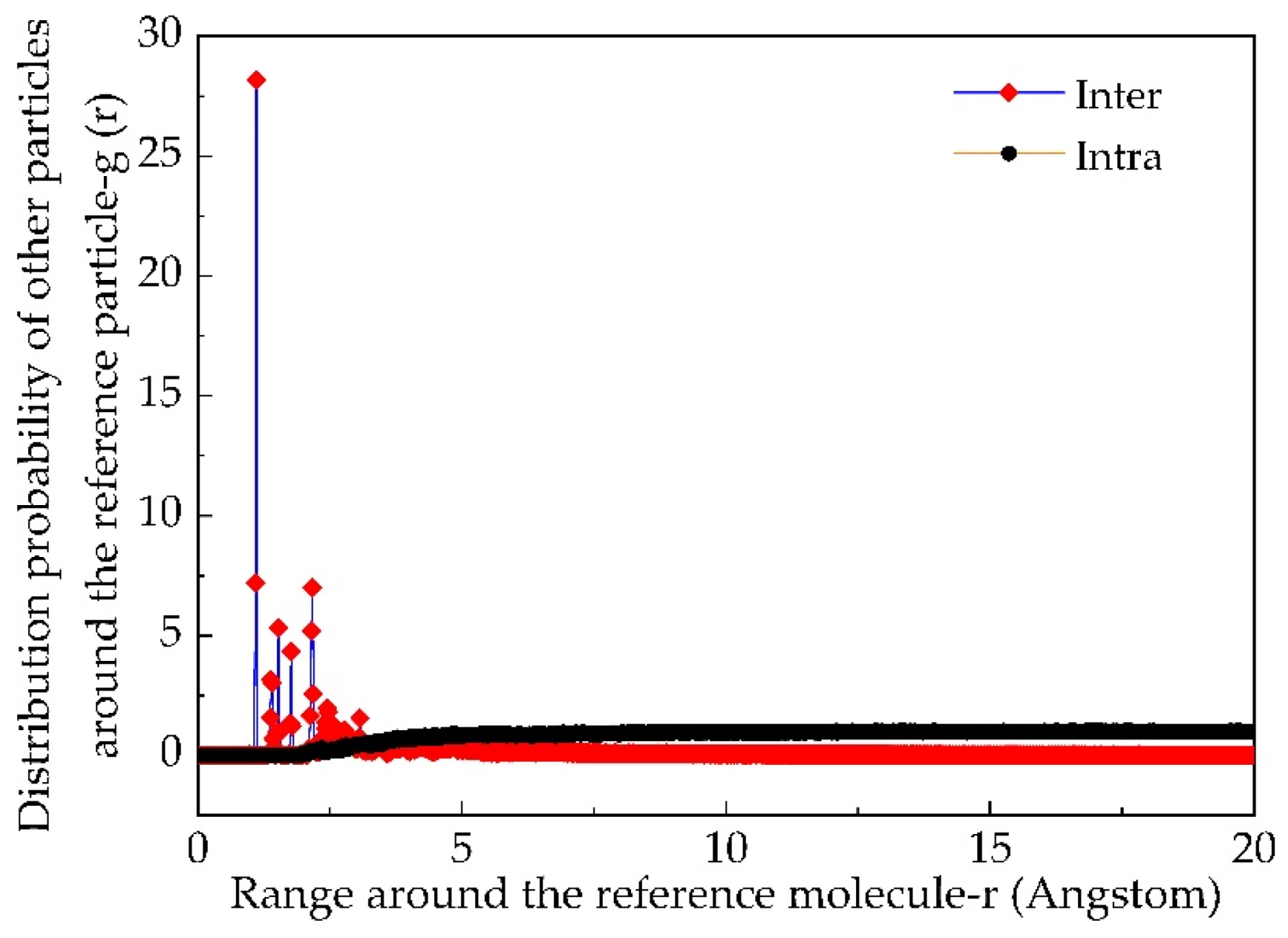

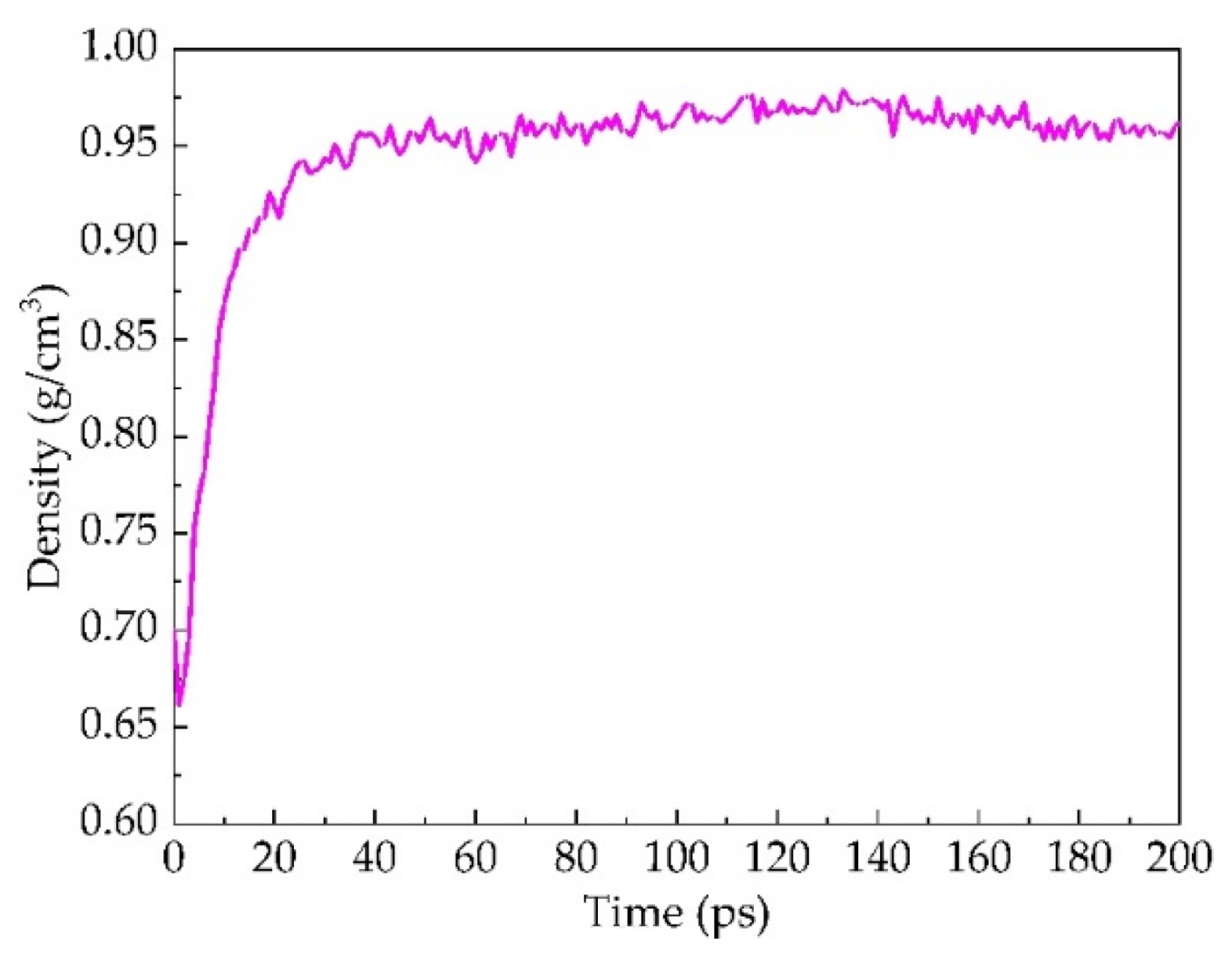
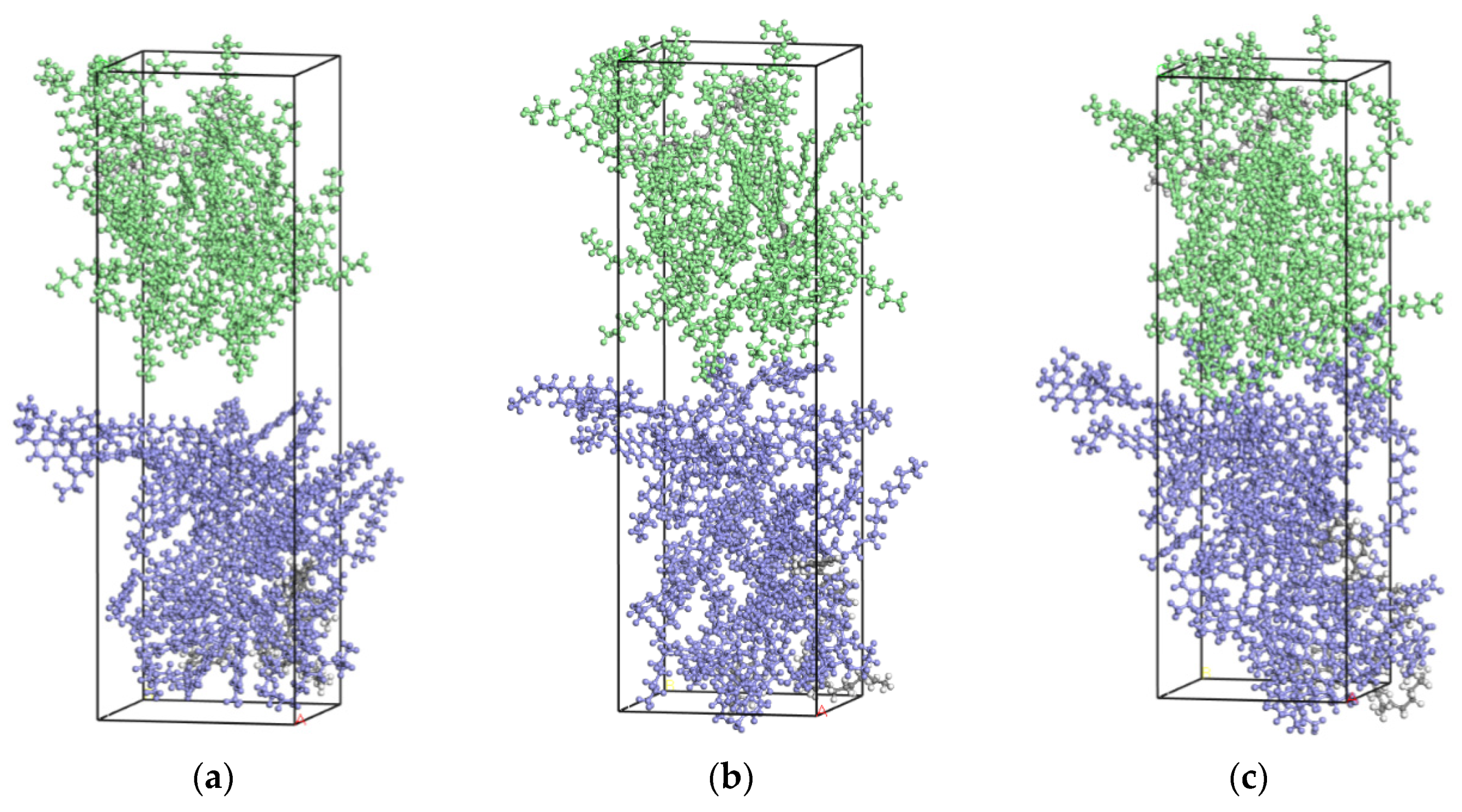
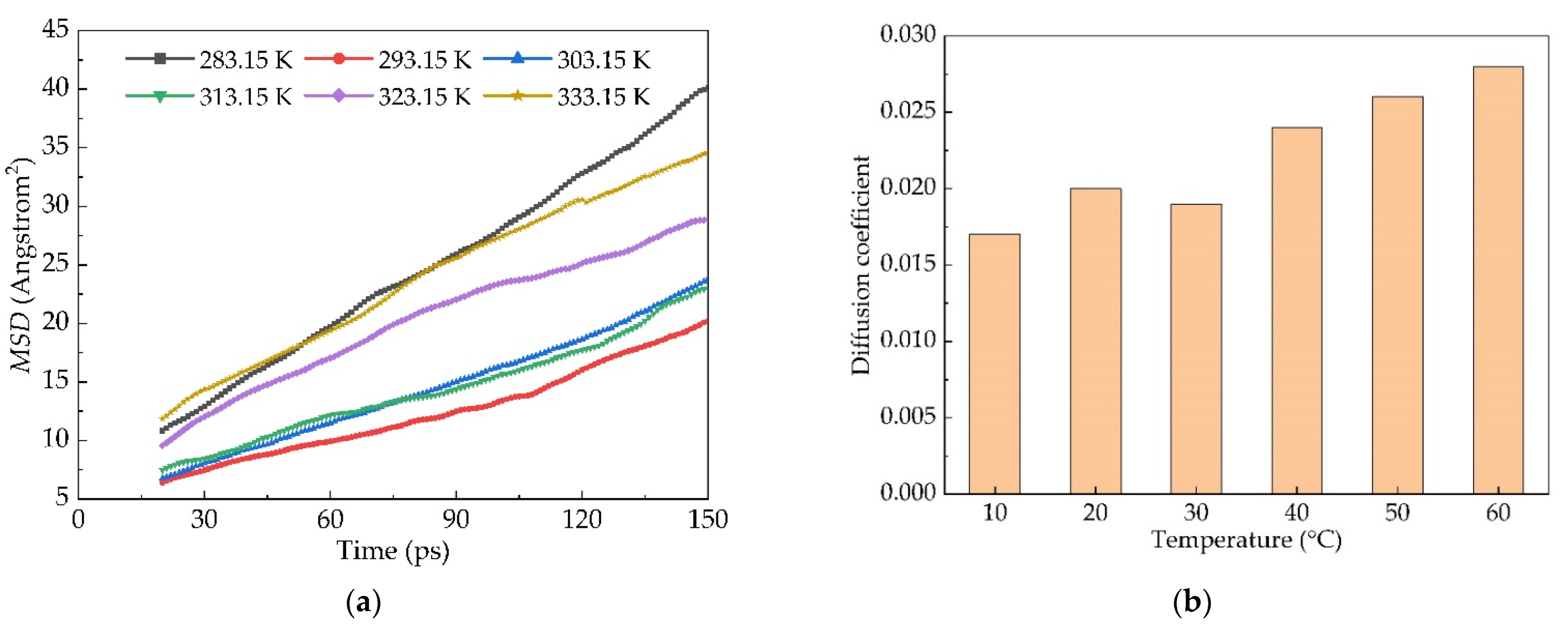
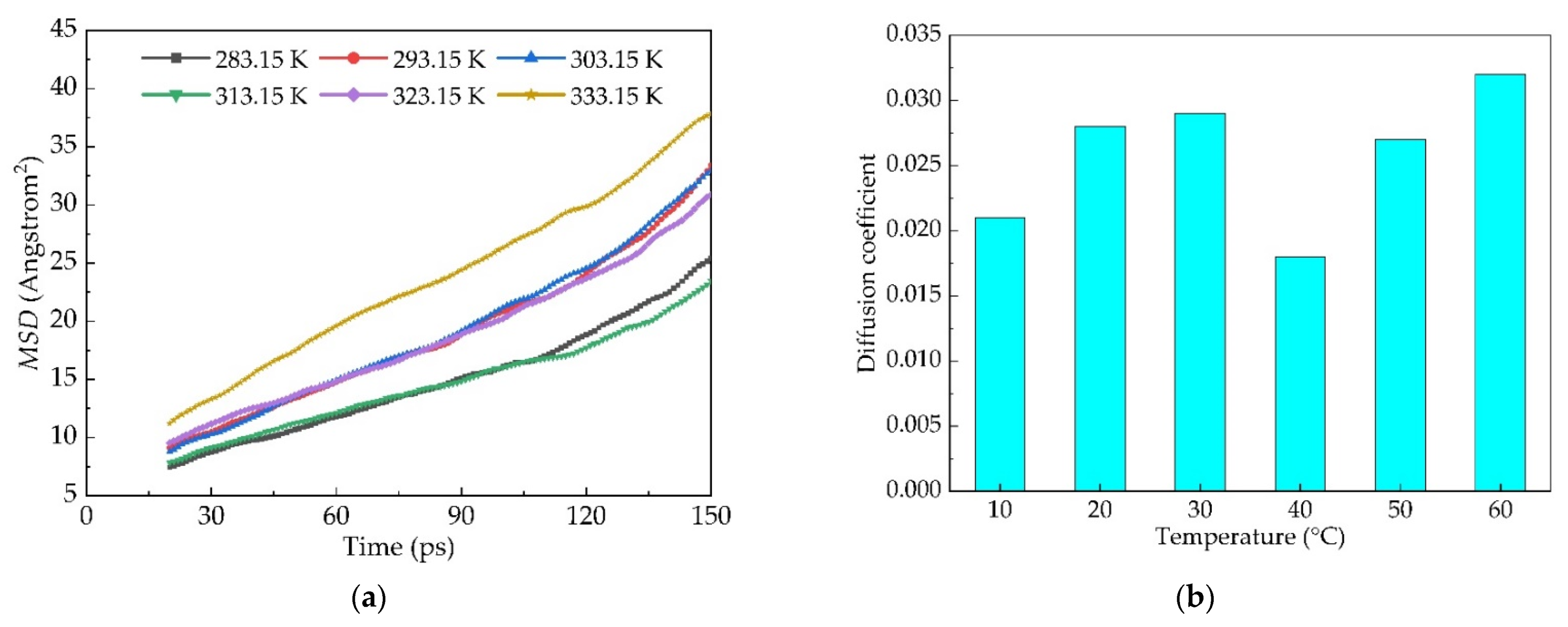
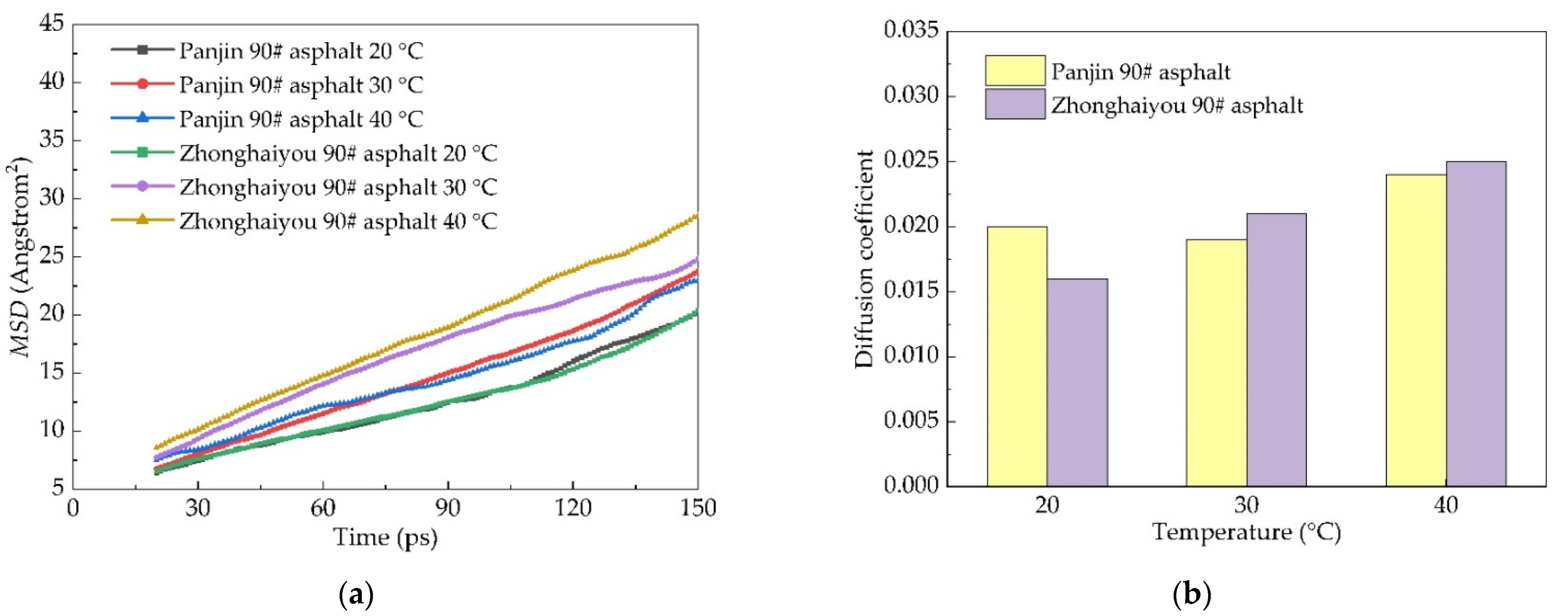

| Asphalt Type | Asphaltenes (%) | Naphthene Aromatics (%) | Polar Aromatics (%) | Saturates (%) |
|---|---|---|---|---|
| Panjin 90# asphalt | 6.47 | 33.57 | 28.07 | 31.89 |
| Aging Panjin 90# asphalt | 14.96 | 38.83 | 18.55 | 27.66 |
| Zhonghaiyou 90# asphalt | 5.07 | 45.17 | 31.55 | 18.21 |
| Aging Zhonghaiyou 90# asphalt | 12.08 | 35.89 | 30.32 | 21.70 |
| Asphalt Type | Asphaltenes | Naphthene Aromatics | Polar Aromatics | Saturates |
|---|---|---|---|---|
| Panjin 90# asphalt | 15.31 | 16.36 | 18.51 | 14.57 |
| Zhonghaiyou 90# asphalt | 14.20 | 17.58 | 18.51 | 14.57 |
Publisher’s Note: MDPI stays neutral with regard to jurisdictional claims in published maps and institutional affiliations. |
© 2021 by the authors. Licensee MDPI, Basel, Switzerland. This article is an open access article distributed under the terms and conditions of the Creative Commons Attribution (CC BY) license (https://creativecommons.org/licenses/by/4.0/).
Share and Cite
Zhou, P.; Wang, W.; Yu, Z. Analysis of Interface Fusion Effect between Old and New Asphalt under Plant Mixing and Cold Recycling Mode Based on Molecular Dynamics Simulation. Materials 2021, 14, 4637. https://doi.org/10.3390/ma14164637
Zhou P, Wang W, Yu Z. Analysis of Interface Fusion Effect between Old and New Asphalt under Plant Mixing and Cold Recycling Mode Based on Molecular Dynamics Simulation. Materials. 2021; 14(16):4637. https://doi.org/10.3390/ma14164637
Chicago/Turabian StyleZhou, Peilei, Wensheng Wang, and Zhe Yu. 2021. "Analysis of Interface Fusion Effect between Old and New Asphalt under Plant Mixing and Cold Recycling Mode Based on Molecular Dynamics Simulation" Materials 14, no. 16: 4637. https://doi.org/10.3390/ma14164637
APA StyleZhou, P., Wang, W., & Yu, Z. (2021). Analysis of Interface Fusion Effect between Old and New Asphalt under Plant Mixing and Cold Recycling Mode Based on Molecular Dynamics Simulation. Materials, 14(16), 4637. https://doi.org/10.3390/ma14164637







